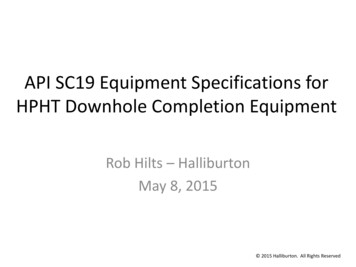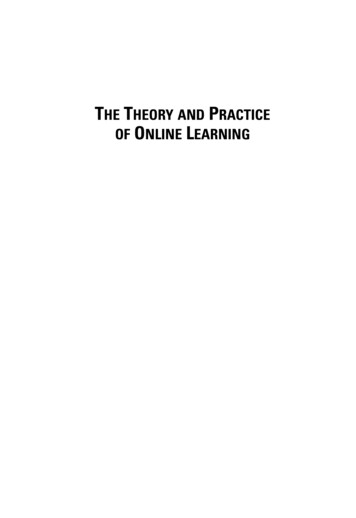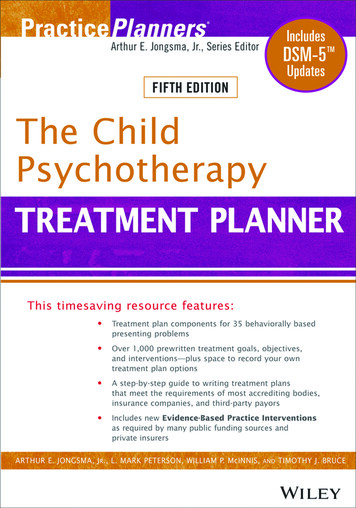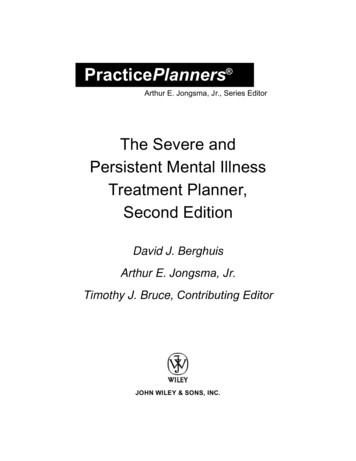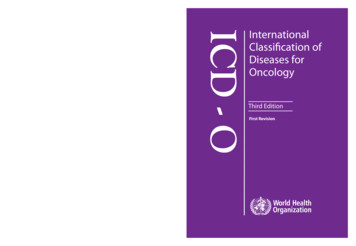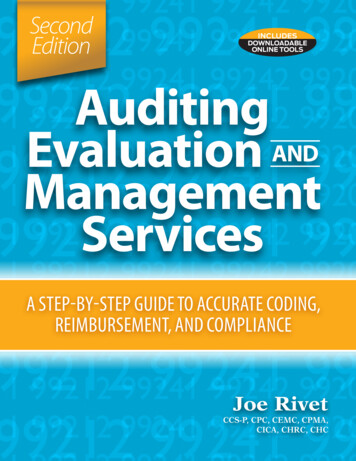
Transcription
SecondEditionINCLUDESDOWNLOADABLEONLINE TOOLSAuditingEvaluation andManagementServicesA Step-By-Step Guide to Accurate Coding,Reimbursement, and ComplianceJoe RivetCCS-P, CPC, CEMC, CPMA,CICA, CHRC, CHC
SecondEditionAuditingEvaluation andManagementServicesA Step-By-Step Guide to Accurate Coding,Reimbursement, and ComplianceJoe RivetCCS-P, CPC, CEMC, CPMA, CICA, CHRC, CHC
Auditing Evaluation and Management Services: A Step-by-Step Guide to Accurate Coding, Reimbursement, and Compliance,Second Edition, is published by HCPro, Inc.Copyright 2011 HCPro, Inc.All rights reserved. Printed in the United States of America.5 4 3 2 1Download the additional materials of this book with the purchase of this product.ISBN: 978-1-60146-821-5No part of this publication may be reproduced, in any form or by any means, without prior written consent of HCPro, Inc., orthe Copyright Clearance Center (978/750-8400). Please notify us immediately if you have received an unauthorized copy.HCPro, Inc., provides information resources for the healthcare industry. HCPro, Inc., is not affiliated in any way with TheJoint Commission, which owns the JCAHO and Joint Commission trademarks.CPT copyright 2010 American Medical Association. All rights reserved. CPT is a registered trademark of the AmericanMedical Association.Joe Rivet, CCS-P, CPC, CEMC, CPMA, CICA, CHRC, CHC, AuthorGerianne Spanek, Managing EditorIlene MacDonald, CPC, Executive EditorLauren McLeod, Group PublisherMike Mirabello, Senior Graphic ArtistMatt Sharpe, Production SupervisorShane Katz, Art DirectorJean St. Pierre, Senior Director of OperationsAdvice given is general. Readers should consult professional counsel for specific legal, ethical, or clinical questions.Arrangements can be made for quantity discounts. For more information, contact:HCPro, Inc.75 Sylvan Street, Suite A-101Danvers, MA 01923Telephone: 800/650-6787 or 781/639-1872Fax: 800/639-8511E-mail: customerservice@hcpro.comVisit HCPro online at: www.hcpro.com and www.hcmarketplace.com06/201121893
CONTENTSAbout the Author. viiSpecial Acknowledgment.ixIntroduction.xiImportance of Auditing E/M Codes.xiCommon Auditing Errors.xiiE/M-Related Resources. xiiiE/M Guidelines: 1995 and 1997. xivDocumentation Essentials.xvAdministrative Buy-In.xvHow This Book Will Help You. xviHow This Book Is Organized. xviAdditional Resources. xviiiContinuing Education Information. xixTarget Audience. xixStatement of Need.xxEducational Objectives.xxFaculty. xxiAmerican Academy of Professional Coders. xxiiAuditing Evaluation and Management Services, Second Edition 2011 HCPro, Inc.iii
ContentsAmerican Health Information Management Association. xxiiContinuing Education Instructions. xxiiChapter 1: E/M Code Categories. 1New Patient. 3Established Patient. 4FAQs: New and Established Patients. 5Category Selection. 6Summary. 15Chapter 2: Selecting an E/M Code. 17E/M Code Components. 19Chapter 3: Conducting a Risk Assessment. 41High-Risk Areas to Monitor. 43Five Steps to Include. 46Risk Data Categories. 49Factors That Can Affect Risk. 50Regulatory Agencies. 52Data Mining. 52Chapter 4: E/M Audit Structure. 55Getting Started. 57Selecting an Auditor. 59Preaudit Preparations. 59Deciding When to Audit. 62Establishing a Baseline. 63Tracking Audit Results. 66iv 2011 HCPro, Inc.Auditing Evaluation and Management Services, Second Edition
ContentsAuditing Teaching Physicians. 67Establishing an Audit Cycle. 68Scoring Providers With a Matrix. 69Other Audit Considerations. 72Chapter 5: Using an Audit Tool. 73Sample Medical Record Documentation. 75History. 76Exam. 80Medical Decision-Making. 84Final Audit Results. 90Chapter 6: Packaging an Audit. 93Necessary Reports in an Audit Package. 96Additional Documents to Consider for Inclusion. 99Chapter 7: Facility E/M Services.101Facility Guidelines. 104Facility E/M Distribution. 107Risk Areas. 108Chapter 8: Teaching Physician Services.111E/M Services. 113Modifier -GC. 114Primary Care Exception. 114Modifier -GE. 115Procedures. 116Audit Criteria. 116Auditing Evaluation and Management Services, Second Edition 2011 HCPro, Inc.v
ContentsAttestation Statements. 117Fraud Cases. 119Chapter 9: Developing a Compliance Plan. 121Plan Overview. 124Audit Policy/Procedure. 125New Provider Orientation. 126Outlier Providers. 127Ongoing Education. 128Other Information to Include. 131Chapter 10: Education Techniques. 133Creative Ideas. 135Education Development. 135Tips. 137vi 2011 HCPro, Inc.Auditing Evaluation and Management Services, Second Edition
ABOUT THE AUTHORJoe Rivet, CCS-P, CPC, CEMC, CPMA, CICA, CHRC, CHCJoe Rivet is the corporate compliance officer at Wayne State University Physician Group, a largephysician group affiliated with Wayne State University School of Medicine in Detroit. He has directresponsibility for all compliance activities, including coordinating, communicating, planning,implementing, and monitoring the compliance program.Rivet previously was a coding compliance specialist at Hall Render Killian Heath & Lyman in Troy,MI, the nation’s second largest health law firm, where he served as a subject matter expert forattorneys and clients. He conducted audits for clients as part of routine compliance programs andas a result of external investigations. He also educated providers and their coding and billing staffabout various coding compliance subjects.Before joining Hall Render, Rivet was a regulatory specialist at HCPro, Inc., in Danvers, MA.He taught the Certified Coding Boot Camp and helped develop the E/M Boot Camp . He alsoserved as the lead consultant for the company’s Revenue Cycle Institute and as an instructor forthe Department of Justice Medicaid Integrity Institute.Previously, Rivet was a revenue manager in the Department of Internal Medicine at Henry FordHealth System in Detroit, where he managed the revenue cycle process and conducted codingaudits, including special investigation unit audits and routine monitoring audits in several practiceareas. Rivet joined Henry Ford, a 3 billion health system consisting of five hospitals and morethan 1,800 providers representing more than 40 different specialties, as a medical billing auditor IIAuditing Evaluation and Management Services, Second Edition 2011 HCPro, Inc.vii
About the Authorin 2004. In this position, he developed audit standards for departmental medical billing, workprograms for billing audits, and audit protocols. He helped identify risk exposure and controlweaknesses. He also served as a compliance specialist at Henry Ford. In this role, he draftedpolicies, created a compliance risk assessment, and educated staff on general compliance topics.Rivet began his coding career in 1997 at PeaceHealth in Longview, WA, a 180-bed hospital witha multispecialty medical group of 175 providers. There he worked as a patient financial servicesrepresentative and a data entry operator. Rivet became an emergency department coder atPeaceHealth in 1999; he was responsible for coding emergency department services, outpatientrecords, trauma services, laboratory services, and labor and industry claims. He also performedevaluation and management (E/M) and Current Procedural Terminology (CPT ) coding foremergency department facility and professional services. Rivet became PeaceHealth’s E/M codingauditor in 2002. His responsibilities included conducting routine prospective documentation andE/M coding audits, communicating audit results, providing expert coding advice to clinicians on adaily basis, and supporting patient financial services to enhance coding accuracy.He has written articles for E-Perspectives, published by the Association of Healthcare InternalAuditors; BC Advantage, published by Billing-Coding.com; Justcoding.com, published by HCPro,Inc.; and Briefings on APCs, also published by HCPro, Inc. His numerous presentations addresstopics such as emergency department coding, coding and billing audits, and coding compliance.Rivet is a former member of the American Health Information Management Association’s Pro fessional Ethics Committee and Certified Construction Committee. He is active in several pro fessional associations, including the American Academy of Professional Coders, the Association ofHealthcare Internal Auditors, and the Health Care Compliance Association. He frequently presentseducation sessions for various professional organizations.viii 2011 HCPro, Inc.Auditing Evaluation and Management Services, Second Edition
Special AcknowledgmentSharon Bolarakis, CPC, CPMA, PMCCSharon Bolarakis is co-author of the first edition of Auditing Evaluation and Management Coding:A Step-By-Step Guide to Enhancing Your Practice’s Revenue and Compliance.Bolarakis is a coding and compliance consultant in the healthcare practice management, consult ing, and billing divisions at Navigant Consulting, formerly EthosPartners HealthCare ManagementGroup, where she also serves on the corporate compliance committee. Her responsibilities includeconducting evaluation and management (E/M) audits and providing physician and staff education.Previously, Bolarakis was a coding and compliance auditor at OrthoCarolina, where her responsi bilities included coding spine surgeries, physiatrist procedures, and general orthopedic procedures.She also audited physicians’ E/M documentation and provided physician and staff education. Earlierin her career, she was a senior compliance specialist and spine coder at Carolinas HealthCareSystem. In this role, she audited approximately 100 physicians once or twice annually withdocumentation criteria, diagnosis coding, correct linking to procedures, modifiers, and missedrevenue as her primary focus.Her health information management career began more than 20 years ago. Beginning as a unitsecretary at a spine center, she became a medical transcriptionist and then a billing managerbefore venturing into health insurance, reimbursement, coding, and compliance.Bolarakis is a regular contributor to HCPro’s JustCoding.com and she has shared her expertiseduring its audio conferences.Auditing Evaluation and Management Services, Second Edition 2011 HCPro, Inc.ix
Special AcknowledgmentHCPro, Inc., and Joe Rivet, her first edition co-author and author of this second edition, AuditingEvaluation and Management Services: A Step-By-Step Guide to Accurate Coding, Reimbursement,and Compliance, gratefully acknowledge her contribution.x 2011 HCPro, Inc.Auditing Evaluation and Management Services, Second Edition
IntroductionEvaluation and management (E/M) codes describe the complexity of the professional services thata provider renders during a visit. The American Medical Association (AMA) publishes its CurrentProcedural Terminology (CPT ) codes in a manual it updates annually. These codes representoffice, hospital, and nursing home visits, as well as consultations and other nonprocedural services.Importance of Auditing E/M CodesWhether a practice is small or large, E/M coding is an integral part of the revenue cycle. In 2002,the Centers for Medicare & Medicaid Services (CMS) allowed approximately 18 billion per year forpayment of E/M services. In 2009, that allotment increased to 25 billion, representing 19% of thetotal Medicare Part B payments.Conducting routine audits of E/M coding is best practice for the following reasons: E/M coding represents a significant portion of a practice’s billing and is potentially subject tooverpayment or underpayment Providers often unintentionally code incorrectly due to the complexity of code assignment Providers often inappropriately assign E/M levels because they don’t understand whiche lements of the documentation actually support an E/M level E/M audits help identify areas of opportunities for increased revenue and ways to reducecompliance risks CMS has said that providers are responsible for knowing the rules and regulations that applyto all services billed to MedicareAuditing Evaluation and Management Services, Second Edition 2011 HCPro, Inc.xi
IntroductionCommon Auditing ErrorsThe Department of Health and Human Services Office of Inspector General (OIG) has increasedits auditing efforts regarding E/M coding and has found a significant error rate, which has resultedin overpayment to physician practices.Some specific E/M errors—many of which are among the most common auditors encounter—include overcoding the services denoted by the following CPT codes without providing therequired documentation: 99214, 99215 (office/outpatient visit, established patient) 99203, 99204, 99205 (office/outpatient visit, new patient) 99244, 99245 (office consultation)Auditors also may discover that a practice loses money because it undercodes the services denotedby the following CPT codes, which documentation reveals could be coded at a higher level: 99211, 99212, 99213 (office/outpatient visit, established patient) 99241, 99242 (office consultation)Undercoding often occurs because providers, fearful of becoming outliers or being targeted for anaudit by regulatory agencies or third-party payers, are not comfortable billing higher levels ofservice. Medicare no longer recognizes consultations codes, but many private payers continue todo so; an audit risk exists for providers because these codes typically have the highest reimburse ment among E/M codes.xii 2011 HCPro, Inc.Auditing Evaluation and Management Services, Second Edition
IntroductionE/M-Related ResourcesProviders and auditors should refer to the following resources that publish information related toE/M coding errors: Compliance Program for Individual and Small Group Physician Practices: TheOIG published this compliance guidance to help practices adhere to compliant billing andcoding guidelines. This document provides an example of a compliance program for grouppractices. It also lists common risk areas for physician practices, such as coding and billing,reasonable and necessary services, documentation, and improper inducements, kickbacks,and self-referrals. Access it in the Tools folder and in the Federal Register, Vol. 65, No. 194,October 5, 2000, at http://www.gpoaccess.gov/fr/. Comprehensive Error Rate Testing (CERT): CMS initiated this program in 2002 to trackE/M errors. CMS publishes CERT data, including national E/M error rates and carrier-specificerror rates, available in the Tools folder and at www.cms.gov/cert/. During a CERT review, anindependent contractor selects random samples of claims processed by each CMS contractorand reviews them to verify that paid claims are ac curate. Results included in CERT publications vary by state; information pertaining to specific g eo graphic locations is available. CERTalso publishes data based on national findings and general themes it discovers. Use this datato help guide an audit plan and determine where to focus auditing efforts. OIG Work Plan: This annual OIG publication includes information about services thatthe OIG investigates. Access the Work Plan in the Tools folder and at http://oig.hhs.gov/publications/workplan.asp. Recovery audit contractors (RAC): RACs identify overpayments and underpayments madeby CMS. Four jurisdictions are responsible for specific audit regions. Visit your state’s RACcontractor website frequently to review current audit activities. Access information about RACsin the Tools folder and at www.cms.gov/RAC/.Auditing Evaluation and Management Services, Second Edition 2011 HCPro, Inc.xiii
Introduction Carrier communications: Many carriers regularly publish information about common c odingerrors they encounter. These resources can help practices ensure they have c urrent information with respect to carrier billing protocols and use of coding modifiers with s pecific E/Mservices and procedures. Not all government and commercial carriers treat nurse pr actitioners,midwives, and other midlevel providers similarly. Consult your carrier for s pecific billingrequirements when auditing services performed by a registered nurse, nurse practitioner,physician assistant, nurse midwife, or other midlevel provider or physician e xtender.E/M Guidelines: 1995 and 1997Two sets of E/M coding guidelines published jointly by CMS and the AMA, the 1995 Documen tation Guidelines for Evaluation and Management Services and the 1997 Documentation Guide lines for Evaluation and Management Services, are currently in use.When thinking about the guidelines, remember the following: The two major differences between the 1995 and 1997 guidelines are coding the history ofpresent illness and the exam elements. CMS allows providers to use either set of guidelines depending on which is more advantageous.However, providers may not mix and match the guidelines to support a p articular level of service. Some local state carriers impose further requirements for E/M services. Consult your state’sMedicare carrier for more information.Auditors must thoroughly understand how the two sets of guidelines differ. Without this knowl edge, a practice could be at risk of noncompliance. Auditors must not misconstrue the guidelinesand inappropriately suggest to providers that they can either increase or decrease E/M levels inthe absence of documentation that supports doing so.Access the 1995 and 1997 guidelines in the Tools folder.xiv 2011 HCPro, Inc.Auditing Evaluation and Management Services, Second Edition
IntroductionDocumentation EssentialsA thorough understanding of E/M coding begins with documentation. If it’s not documented, itdidn’t happen. Documentation is crucial to any area of coding and is especially important whendetermining an E/M level. Documentation for E/M services must include: Place of service (i.e., office, outpatient hospital, nursing home, inpatient hospital) Patient status (i.e., new patient, established patient) Type of service (i.e., consultation, office visit)When determining E/M accuracy, begin by asking which level of service the provider selected,which level the provider should have selected, and whether the provider or coder selected theappropriate diagnosis codes.The steps that auditors need to take when conducting an E/M documentation audit, which arediscussed in this book, include the following: Conduct a risk assessment to identify high-risk areas and other elements that can affect risk Design a sample size and payer mix for tracked data Trend information to compare results internally, by region, and by specialty Develop a compliance plan to relay information to providers and establish ongoing monitoringAdministrative Buy-InEliciting input from administrative staff and physician leaders is important for practices that havenever conducted an audit. Physician leadership participation is essential because auditors relyon these individuals to set an example and to relay information to providers throughout theaudit process.Auditing Evaluation and Management Services, Second Edition 2011 HCPro, Inc.xv
IntroductionBegin by presenting the plan to the practice’s administrative leadership or executive team.A positive reception at this level will filter down to staff providers. When presenting the ideato senior leadership, emphasize the following information: The OIG frequently monitors E/M coding The practice could lose much revenue if it does not properly document and codethese s ervices The OIG recommends that every practice establish an ongoing auditing/monitoring system An audit can significantly reduce the practice’s risk, thereby avoiding numerous overpaidclaims that must be refundedHow This Book Will Help YouThis book will guide you through the E/M audit process from beginning to end. You will learnhow to select an E/M code, how to conduct an entire audit of your E/M services, and how toreport your E/M audit findings. E/M audits enhance compliance and can also identify under coding, underreporting, revenue opportunities, and avenues for documentation improvement.This book can help enhance existing auditing programs by exploring different ways to determineE/M error rates that represent an accurate error rate, which can help assess a practice’s risk.How This Book Is OrganizedChapter 1: E/M Code Categories reviews the major E/M categories and provides a workingknowledge of their appropriate use based on the AMA CPT definition. Many E/M categories arestraightforward, but some code categories contain nuances.Chapter 2: Selecting an E/M Code provides a step-by-step approach to E/M code selection,including determining the history, exam, medical decision-making, counseling, coordination ofcare, nature of presenting illness, and time portions of the service.xvi 2011 HCPro, Inc.Auditing Evaluation and Management Services, Second Edition
IntroductionChapter 3: Conducting a Risk Assessment explains how to conduct a risk assessment toinventory risk areas, identify current and potential risks, and control weaknesses. It also explorescommon high-risk areas, useful references auditors can refer to for guidance, and documents toinclude in an assessment.Chapter 4: E/M Audit Structure explains how to structure an audit, including determiningsample size, establishing a baseline, tracking audit results, and determining an audit cycle.Chapter 5: Using an Audit Tool explains the audit process with an audit tool and case studyscenario that highlights the differences between the 1995 and 1997 guidelines.Chapter 6: Packaging an Audit explains how to draft a provider audit summary, a practiceaudit summary, revenue reports, and an action plan.Chapter 7: Facility E/M Services discusses guidelines for clinic and emergency departmentE/M services published in the Federal Register. It discusses suggested E/M level selection for bothclinic and emergency department services.Chapter 8: Teaching Physician Services examines the plethora of Medicare rules that must bemet to report E/M services involving residents or fellows. This chapter also discussesdocumentation components considered acceptable and unacceptable.Ch
as a result of external investigations. He also educated providers and their coding and billing staff about various coding compliance subjects. Before joining Hall Render, Rivet was a regulatory specialist at HCPro, Inc., in Danvers, MA. He taught the Certified Coding Boot Camp and helped develop the E/M Boot Camp . He also


